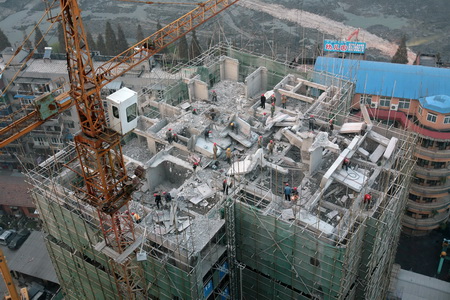Society
Short-lived buildings create huge waste
By Wang Qian (China Daily)
Updated: 2010-04-06 07:47
 |
Large Medium Small |
Poor-quality buildings are major problem
BEIJING: The life span of the average residential building in China, the largest cement consumer in the world, has been blamed for causing tremendous waste.
 Workers demolish a 20-story building that was illegally built in Wuhan, Hubei province, in this Nov 26, 2009. [File photo / China Daily] |
"Every year, new buildings in China total up to 2 billion square meters and use up 40 percent of the world's cement and steel, but our buildings can only stand 25 to 30 years on average," Qiu Baoxing, vice-minister of housing and urban-rural development, said at a recent international forum on green and energy-efficient building.
This means the average life span of China's residential buildings is shorter than their intended life span of 50 years at the blueprint stage. As a result, property developers have been urged to extend the median life span of buildings.
Industry sources have added to the mix by stating that the per unit energy consumption of China's short- lived residential buildings is two or three times that of residential buildings in developed nations.
| ||||
The construction of a 10,000-sq-m building will create 500 to 600 tons of waste, while the demolition of a 10,000-sq-m old building will create 7,000 to 12,000 tons of waste, according to industrial data.
Space from building demolition in China annually constitutes about 40 percent of the total construction area.
Alarm was raised several times in 2009 over the poor quality of the country's buildings.
In October of that year, a six-story apartment block collapsed in Central China's Wuhan, Hubei province. It was later found to have been held together by "steel supports as thin as iron wires", according to the subsequent investigation.
Earlier, in June 2009 a 13-floor building in the Lotus Riverside residential complex in Shanghai toppled, killing one worker. An investigation revealed the building's foundations had been undermined by a combination of soil piled 10 m high on one side of the structure and the digging of a 4.6-m underground car garage on the other.
One month later, a construction pit at the site of a planned building in Nanjing, Jiangsu province, collapsed and is believed to have caused massive cracks on nearby residential buildings.
The series of tragedies aroused nationwide concern over the quality of the country's buildings. In July 2009, the Ministry of Housing and Urban-Rural Development intervened by ordering that housing construction throughout China be inspected for quality.
Covering 180 projects in 90 cities across 30 provinces, the results of the inspection showed that 96.1 percent of the housing construction is qualified, which contrasts sharply with the average life expectancy of the country's buildings.
Compared to the less than 30-year average life expectancy of China's buildings, the average life span of a building in Britain is capable of 132 years and in the United States it is 74 years.
Across the country, many homebuyers and homeowners worry about the quality of the housing stock.
Wang Tingting, a 27-year-old teacher in the Shenyang Conservatory of Music in Shenyang, Liaoning province, who bought a 90-sq-m house early this year, told China Daily that the first time she saw her new house, she found a 10-mm gap between the doorframe and the wall, in addition to a cleft under a bedroom's window.
"Although the developer fixed them, I still worry about the house. Who knows what will happen after I move in," she said.











